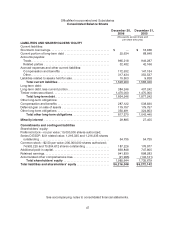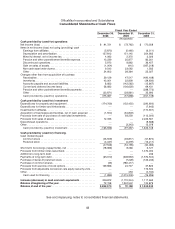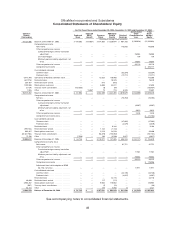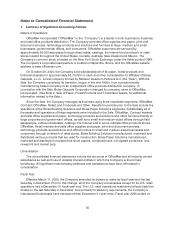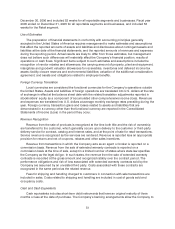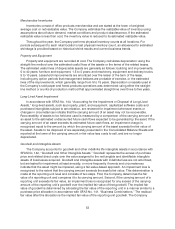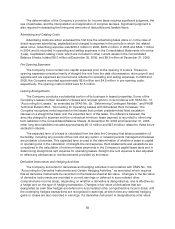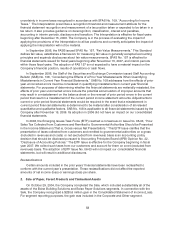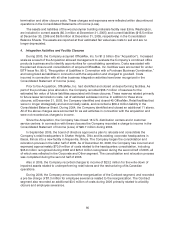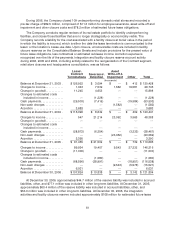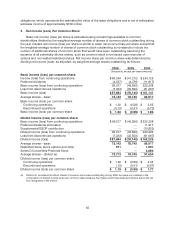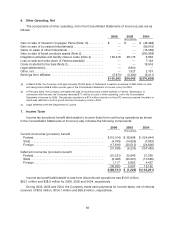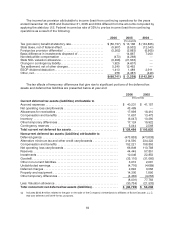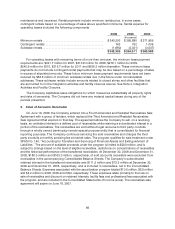OfficeMax 2006 Annual Report Download - page 60
Download and view the complete annual report
Please find page 60 of the 2006 OfficeMax annual report below. You can navigate through the pages in the report by either clicking on the pages listed below, or by using the keyword search tool below to find specific information within the annual report.56
The determination of the Company’s provision for income taxes requires significant judgment, the
use of estimates, and the interpretationand application of complex tax laws. Significant judgment is
also required in assessing the timing and amounts of deductible and taxable items.
Advertising and Catalog Costs
Advertising costs are either expensed the first time the advertising takes place or, in the case of
direct-response advertising, capitalized and chargedto expense in the periods in which the related
sales occur. Advertising expense was $240.4 million in 2006, $276.2 million in 2005 and $344.1 million
in 2004, and is recorded in operating and selling expenses in the Consolidated Statements of Income
(Loss). Capitalized catalog costs, which are included in other current assets in the Consolidated
Balance Sheets, totaled $9.3 million at December 30, 2006, and $9.9 million at December 31, 2005.
Pre-Opening Expenses
The Company incurs certain non-capital expenses prior to the opening of a store. Thesepre-
opening expenses consist primarily of straight-line rent from the dateof possession, store payroll, and
supplies and are expensed asincurred and reflected in operatingand selling expenses. In 2006 and
2005,the Company recorded approximately $5.6 million and $4.5 million in pre-openingcosts,
respectively. Pre-opening costs in 2004 were $1.5 million.
Leasing Arrangements
The Company conducts a substantial portion of its business in leased properties. Some of the
Company’s leases contain escalation clauses and renewal options. In accordance with SFAS No. 13,
“Accounting for Leases,” as amended by SFAS No. 29, “Determining Contingent Rentals,” and FASB
Technical Bulletin 85-3,“Accounting for Operating Leases with Scheduled Rent Increases,” the
Company recognizes rental expense for the leases thatcontain predetermined fixed escalation
clauses on a straight-line basis over the expected term of the lease.The difference betweenthe
amounts charged to expense and the contractual minimum lease payment is recorded to other long-
term liabilities in the Consolidated Balance Sheets. At December 30,2006and December 31, 2005,
other long-term liabilities included approximately $51.3 million and $27.8 million related to these future
escalation clauses.
The expected term of a lease is calculated from the date the Companyfirst takes possession of
thefacility, including any periods of free rent and any option or renewal periods management believes
are probable of exercise. This expected term is used in the determination of whether a lease is capital
or operating and in the calculationofstraight-line rent expense. Rent abatements and escalations are
considered in thecalculation ofminimum lease payments in the Company’s capital lease tests and in
determining straight-line rent expense for operating leases. Straight-line rent expense is also adjusted
to reflect any allowances or reimbursements provided by the lessor.
Derivative Instruments and Hedging Activities
The Company accounts for derivatives and hedging activities in accordance with SFAS No.133,
“Accounting forDerivative Instruments and Certain Hedging Activities,” as amended, which requires
that all derivative instruments be recorded onthe balance sheet at fair value. Changes in the fair value
of derivativeinstruments are recorded in current earnings or deferred inaccumulated other
comprehensive income (loss), depending on whether a derivative is designated as, and is effective as,
a hedge and on the type of hedging transaction. Changes in fair value of derivatives that are
designated as cash flow hedgesare deferred in accumulated other comprehensiveincome (loss) until
the underlying hedged transactions are recognized in earnings, at which time any deferred hedging
gains or losses are also recorded in earnings. If a derivative instrumentis designated as a fairvalue



